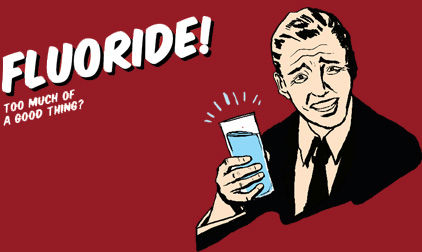Is drinking water fluoridation safe and effective? New science reveals that fluoride is a developmental neurotoxin and an endocrine disruptor. The CDC tells us that drinking fluoride decreases tooth decay, at best, by 25%. Is one less cavity worth risking a child’s long-term brain and thyroid health? Watch the film Our Daily Dose and read the critique by Paul Connett.


50 Reasons to Oppose Fluoridation
Excerpt By Paul Connett PhD, Published in Medical Veritas
In Europe, only Ireland (73%), Poland (1%), Serbia (3%), Spain (11%), and the U.K. (11%) fluoridate any of their water. Most developed countries, including Japan and 97% of the western European population, do not consume fluoridated water.
In the U.S., about 70% of public water supplies are fluoridated. This equates to approximately 185 million people, which is over half the number of people drinking artificially fluoridated water worldwide. Some countries have areas with high natural fluoride levels in the water. These include India, China and parts of Africa. In these countries measures are being taken to remove the fluoride because of the health problems that fluoride can cause.
Fluoridation is a bad medical practice
1) Fluoride is the only chemical added to water for the purpose of medical treatment. The U.S. Food and Drug Administration (FDA) classifies fluoride as a drug when used to prevent or mitigate disease (FDA 2000). As a matter of basic logic, adding fluoride to water for the sole purpose of preventing tooth decay (a non-waterborne disease) is a form of medical treatment. All other water treatment chemicals are added to improve the water’s quality or safety, which fluoride does not do.

Watch this video on YouTube
Our Daily Dose, a documentary by Jeremy Seifert, www.ourdailydose.com
2) Fluoridation is unethical. Informed consent is standard practice for all medication, and one of the key reasons why most of Western Europe has ruled against fluoridation. With water fluoridation we are allowing governments to do to whole communities (forcing people to take a medicine irrespective of their consent) what individual doctors cannot do to individual patients.
Put another way: Does a voter have the right to require that their neighbor ingest a certain medication (even if it is against that neighbor’s will)?
One way of avoiding the fluoride from tap water is to purchase a water filter. Not all water filters, however, remove fluoride. The three types of filters that can remove fluoride are reverse osmosis, deionizers (which use ion-exchange resins), and activated alumina.
3) The dose cannot be controlled. Once fluoride is put in the water it is impossible to control the dose each individual receives because people drink different amounts of water. Being able to control the dose a patient receives is critical. Some people (e.g., manual laborers, athletes, diabetics, and people with kidney disease) drink substantially more water than others.
4) The fluoride goes to everyone regardless of age, health or vulnerability. According to Dr. Arvid Carlsson, the 2000 Nobel Laureate in Medicine and Physiology and one of the scientists who helped keep fluoridation out of Sweden:
“Water fluoridation goes against leading principles of pharmacotherapy, which is progressing from a stereotyped medication — of the type 1 tablet 3 times a day — to a much more individualized therapy as regards both dosage and selection of drugs. The addition of drugs to the drinking water means exactly the opposite of an individualized therapy” (Carlsson 1978).
How to remove fluoride from your body? Sunshine. Iodine supplementation. Tamarind as a tea or tincture. Apple Cider Vinegar can help de-calcify the pineal gland.


5) People now receive fluoride from many other sources besides water. Fluoridated water is not the only way people are exposed to fluoride. Other sources of fluoride include food and beverages processed with fluoridated water (Kiritsy 1996; Heilman 1999), fluoridated dental products (Bentley 1999; Levy 1999), mechanically deboned meat (Fein 2001), tea (Levy 1999), and pesticide residues (e.g., from cryolite) on food (Stannard 1991; Burgstahler 1997). It is now widely acknowledged that exposure to non-water sources of fluoride has significantly increased since the water fluoridation program first began (NRC 2006).
6) Fluoride is not an essential nutrient. No disease, not even tooth decay, is caused by a “fluoride deficiency.”(NRC 1993; Institute of Medicine 1997, NRC 2006). Not a single biological process has been shown to require fluoride. On the contrary there is extensive evidence that fluoride can interfere with many important biological processes. Fluoride interferes with numerous enzymes (Waldbott 1978). In combination with aluminum, fluoride interferes with G-proteins (Bigay 1985, 1987). Such interactions give aluminum-fluoride complexes the potential to interfere with signals from growth factors, hormones and neurotransmitters (Strunecka & Patocka 1999; Li 2003). More and more studies indicate that fluoride can interfere with biochemistry in fundamental ways (Barbier 2010).
7) The level in mothers’ milk is very low. Considering reason #6 it is perhaps not surprising that the level of fluoride in mother’s milk is remarkably low (0.004 ppm, NRC, 2006). This means that a bottle-fed baby consuming fluoridated water (0.6 – 1.2 ppm) can get up to 300 times more fluoride than a breast-fed baby. There are no benefits (see reasons #11-19), only risks (see reasons #21-36), for infants ingesting this heightened level of fluoride at such an early age (an age where susceptibility to environmental toxins is particularly high).
Because of their sole reliance on liquids for their food intake, infants consuming formula made with fluoridated water have the highest exposure to fluoride, by bodyweight, in the population.
8 ) Fluoride accumulates in the body. Healthy adult kidneys excrete 50 to 60% of the fluoride ingested each day (Marier & Rose 1971). The remainder accumulates in the body, largely in calcifying tissues such as the bones and pineal gland (Luke 1997, 2001). Infants and children excrete less fluoride from their kidneys and take up to 80% of ingested fluoride into their bones (Ekstrand 1994). The fluoride concentration in bone steadily increases over a lifetime (NRC 2006).
According to the National Research Council (2006), “it is apparent that fluorides have the ability to interfere with the functions of the brain.” In a review of the literature commissioned by the US Environmental Protection Agency (EPA), fluoride has been listed among about 100 chemicals for which there is “substantial evidence of developmental neurotoxicity.”
9) No health agency in fluoridated countries is monitoring fluoride exposure or side effects. No regular measurements are being made of the levels of fluoride in urine, blood, bones, hair, or nails of either the general population or sensitive subparts of the population (e.g., individuals with kidney disease).
There have now been 33 studies from China, Iran, India and Mexico that have reported an association between fluoride exposure and reduced IQ.
10) There has never been a single randomized controlled trial to demonstrate fluoridation’s effectiveness or safety. Despite the fact that fluoride has been added to community water supplies for over 60 years, “there have been no randomized trials of water fluoridation” (Cheng 2007). Randomized trials are the standard method for determining the safety and effectiveness of any purportedly beneficial medical treatment. In 2000, the British Government’s “York Review” could not give a single fluoridation trial a Grade A classification – despite 50 years of research (McDonagh 2000). The U.S. Food and Drug Administration (FDA) continues to classify fluoride as an “unapproved new drug.”
To Read the 40 Other Reasons to Oppose Fluoridation, Click Here.
The film Our Daily Dose can also be downloaded (for $10) at https://vimeo.com/ondemand/ourdailydose













hi there
what is the dose for boron citrate tablets for fluoride detox? i have 3 mgs tablets?
and, some say 20 mule boxed borax at 1/4 teaspoon to full level teaspoon per 4 litres water detox fluoride? correct?
and, will regular vinegar detox the herbicide roundup glysophate that is also a poison?
email me if you could!
appreciate it